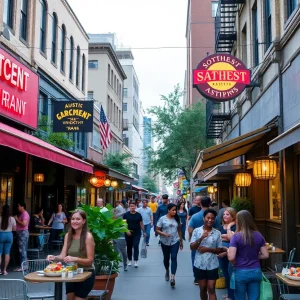Austin’s Transportation Challenge Takes Center Stage in Upcoming Mayoral Elections
The city of Austin is poised to tackle its growing transportation challenges head-on as citizens prepare to cast their votes in the upcoming mayoral elections. Transportation is not just a key issue for the city; it’s a topic that nearly every voter will confront as they navigate busy streets on their way to polling stations. The future of transit in Austin rests significantly in the hands of the mayor and the City Council.
Project Connect and Light-Rail System Developments
In November 2020, residents approved a historic funding plan for Project Connect, which promises to transform public transit in Austin. Voters agreed to raise property taxes to finance expanded bus service, commuter rail improvements, park-and-rides, and a light-rail system. Currently, the proposed light-rail system consists of a 9.8-mile route primarily along Guadalupe Street, a significant reduction from the originally planned 20.2 miles. A previous plan for a downtown subway was scrapped as costs soared beyond expectations.
Despite this ambitious plan, opposition emerged, leading to two ongoing lawsuits against the city aimed at halting Project Connect. Critics argue that the current transit proposal does not align with what voters envisioned during the approval process.
Roles of the City Council and Capital Metro
Austin’s City Council holds a critical role in shaping public transit. Although the council can appoint members to the Capital Metro Board, which governs public transit in the city, the mayor’s influence often overshadows other members’ voices. Capital Metro is responsible for operating bus and transit services, making the actual execution of Project Connect contingent on this independent agency.
Major I-35 Expansion Plans
In addition to public transit improvements, Austin faces the massive expansion of I-35, the city’s main interstate. Construction efforts are beginning, focusing on the most disruptive area — downtown. City officials want to invest over $800 million to cover parts of the highway, introducing parks and community spaces over the roadway.
This is not without controversy, as civil rights complaints allege that the project overlooks potential environmental injustices. Opponents of the expansion argue for less burdensome alternatives and raise concerns regarding air and water quality, although the Texas Department of Transportation (TxDOT) defends the project.
Airport Expansion Underway
Meanwhile, the Austin-Bergstrom International Airport (ABIA) is also expanding due to increased passenger numbers, with around 22 million travelers passing through an airport designed for only 15 million. The city’s expansion plans include a new terminal with at least 20 gates to enhance airport facilities.
However, conflict arose during this expansion as the city utilized eminent domain to reclaim lease rights from a private operator. The matter ended with the city needing to pay $90 million to resolve the situation.
Long-Range Transportation Goals
Austin’s long-term transportation strategy aims to reduce single-occupancy vehicle usage by 50% by 2039. Currently, approximately 74% of commuters drive alone to work. The city wishes to shift commuting behaviors by promoting public transit, biking, and carpooling to tackle congestion.
To encourage less driving, the city has also altered street layouts to make room for pedestrians and cyclists, a move that has sparked debate among local citizens.
Mayoral Candidates’ Perspectives on Transit Issues
The upcoming election is not just about votes; it is also about positions on transit. Each candidate has shared their perspectives on major transportation projects. Some candidates express concern over the reduced scope of Project Connect compared to the original proposal, while others see the current reductions as practical under the circumstances.
As I-35 expansion plans proceed, candidates have differing views on the merits of this project, some supporting it for its speed benefits while others raise concerns about long-term traffic impacts. Similarly, as ABIA continues to grow, candidates agree on the potential for expanded jobs, though they voice varying opinions on the execution of those plans.
Conclusion
Transportation remains a top priority in Austin, highlighted significantly in this election cycle. With ongoing changes and challenges, how candidates propose to address these issues will shape the city’s commuting landscape for years to come. As residents prepare to vote, every candidate’s approach to transit will matter in determining Austin’s future.









